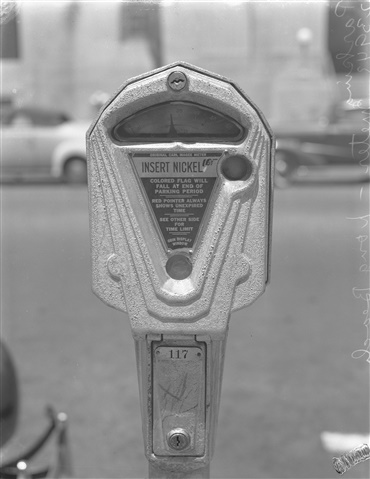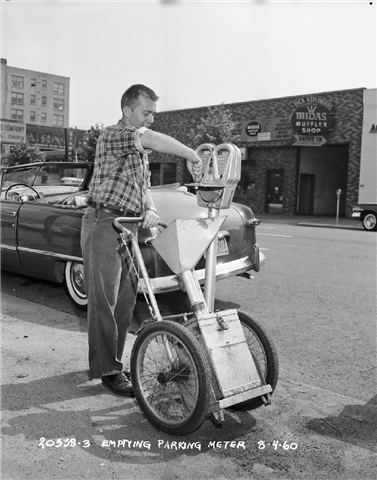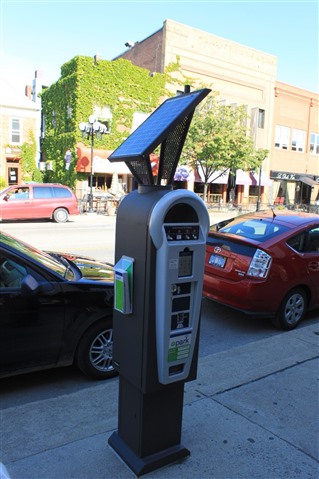We complain about it, but our towns and cities would become impassable without this engineering achievement...
July 16, 1935 - The world's first parking meter is installed
Another hot, dry summer day in Oklahoma City, Oklahoma, USA. On the corner of First Street and Robinson Avenue, workers are setting up strange contraptions on the sidewalk's edge. When people try to park their cars on the road next to the new devices, they have a surprise. Now, they have to pay for every minute they want to leave their vehicles in the street, up to an hour. The bane of the modern urban motorist is here: the world's first parking meter.
The birth of a modern problem
In the first 20 years of the 20th Century, towns and cities in the United States were filling up with motor cars, for which there was not enough parking space. Downtown areas and central business districts would fill with parked cars (usually urban office workers) choking the movement of people and traffic. Parking became a chaotic potluck.
This made it harder for anyone in a car to get to the places they wanted to visit…because the space was already packed with vehicles. Municipalities struggled to find a solution to the new problem. Some placed time limits on city centre parking, using police officers to patrol a street, marking the tires of parked cars with chalk. Los Angeles, California upset its motorists by banning city centre car parking in daylight hours. Other cities went further, banning cars outright from their centres.

The humble parking meter, 1940s. Source: Wikimedia Commons
Because this meant potential paying customers could not park near their stores, storekeepers felt especially hard done by. What to do?
You got a friend in me
The shopkeepers of Oklahoma City were no different. Fuming retail owners took the matter to the Oklahoma City Chamber of Commerce, where a member of the Traffic Committee just happened to be local newspaperman and lawyer Carl C. Magee. He had arrived in Oklahoma City in 1927, setting up the Oklahoma News. He brought with him a reputation as a campaigning investigative journalist.
A Federal Secretary of the Interior, Albert B. Fall, had gone to prison when his part in the Teapot Dome Scandal - renting government-owned land in Wyoming to private oil companies in return for kickbacks and favors - was exposed by an investigation in which Magee played a key role.
Carl Magee was also an inventor who had long been pondering the parking problem. Back in 1932, he had designed and patented his own parking meter. To improve the machine, he combined with the engineering department of Oklahoma Agricultural and Mechanical College (now Oklahoma State University), which launched a competition for a serviceable design. When none proved suitable, Magee was joined by Professor Holger George Thuesen, a former student and a college graduate, Gerald A. Hale.
Winding it up
The first patented (on August 30, 1928) parking meter was developed by Roger W. Babson, Its drawback was the need be connected to the battery of whatever vehicle it was timing.
The new Magee-Thuesen-Hale model, the 'Black Maria,' worked on a clock spring, wound by the user after putting coins into the slot. The trio made the internal components, while a local plumber produced the external shell. By 1933, a company out of Tulsa, Oklahoma - the MackNick Company made timing devices used in nitroglycerin detonators for oil wells – was contracted to manufacture the black maria.
The first 175 meters were installed, 20 feet apart, on July 16, 1935, over 14 city blocks. Soon after, their success allowed the black maria to be rolled out across Oklahoma City's downtown.
Magee opened the Dual Parking Meter Company with Hale, headquartered at the city's Commerce and Exchange Building, later becoming Park-O-Meter, making the meters held under Magee's patent. After World War Two, this became the Magee-Hale Park-O-Meter Company, later selling out to a business over in Ohio.
The birth of another modern problem

A worker in Seattle empties a parking meter. Source: Wikimedia Commons
For a nickel (5 US cents) an hour, people could buy time to park their cars in designated spaces. The results were immediate. The streets freed up, and parking became far easier, ending the earlier chaos, which pleased retailers and city fathers alike. Store owners were pleased by the newly rapid turnover in customers - who could park but had to be gone in an hour to make way for more customers. City Fathers were pleased by the money (5 cents an hour) that rolled into the local municipality. As did cash from the $20 dollar parking fines for each offence. As the Reverend C.H. North of Oklahoma City would soon find out.
One day in August, just a month after the first meters appeared, the Reverend parked his car beside a black maria, only to find he didn't have the necessary small change. Off he went to a store to get the coins, only to find the world's (presumably) first parking ticket on his windshield when he returned.
The Rev. North sued the parking meter company…and lost. He was the first, but by no means the last, to fall 'victim' to the parking meter. Later, lawsuits launched across the United States failed in getting them banned as unconstitutional – opponents claimed the meters were an unfair tax on cars, and they impinged upon peoples' freedom to move on the streets as they liked. None of this succeeded in preventing the rapid roll-out of the meter across the US.
Another consequence was the growth in the assessed value of commercial, downtown property.

A thoroughly modern, multi-space parking meter. Source: Wikimedia Commons
Carl C Magee remained company president until he died in 1946. By this time, there were over 140,000 parking meters across the country.
The parking meter falls into the category of 'necessary evil'. What other technology would you put into that category? And is it genuinely necessary?
 By Stephen Phillips - IET Content Producer, with passions for history, engineering, tech and the sciences.
By Stephen Phillips - IET Content Producer, with passions for history, engineering, tech and the sciences.
